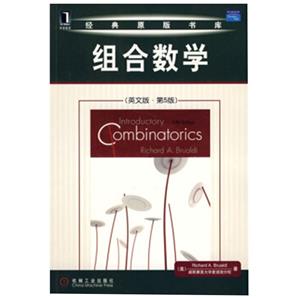包郵 組合數(shù)學(xué)(英文版 第5版)
-
>
全國計(jì)算機(jī)等級(jí)考試最新真考題庫模擬考場(chǎng)及詳解·二級(jí)MSOffice高級(jí)應(yīng)用
-
>
決戰(zhàn)行測(cè)5000題(言語理解與表達(dá))
-
>
軟件性能測(cè)試.分析與調(diào)優(yōu)實(shí)踐之路
-
>
第一行代碼Android
-
>
JAVA持續(xù)交付
-
>
EXCEL最強(qiáng)教科書(完全版)(全彩印刷)
-
>
深度學(xué)習(xí)
組合數(shù)學(xué)(英文版 第5版) 版權(quán)信息
- ISBN:9787111265252
- 條形碼:9787111265252 ; 978-7-111-26525-2
- 裝幀:暫無
- 冊(cè)數(shù):暫無
- 重量:暫無
- 所屬分類:>
組合數(shù)學(xué)(英文版 第5版) 本書特色
《組合數(shù)學(xué)(英文版)(第5版)》是系統(tǒng)闡述組合數(shù)學(xué)基礎(chǔ),理論、方法和實(shí)例的優(yōu)秀教材。出版30多年來多次改版。被MIT、哥倫比亞大學(xué)、UIUC、威斯康星大學(xué)等眾多國外高校采用,對(duì)國內(nèi)外組合數(shù)學(xué)教學(xué)產(chǎn)生了較大影響。也是相關(guān)學(xué)科的主要參考文獻(xiàn)之一。《組合數(shù)學(xué)(英文版)(第5版)》側(cè)重于組合數(shù)學(xué)的概念和思想。包括鴿巢原理、計(jì)數(shù)技術(shù)、排列組合、Polya計(jì)數(shù)法、二項(xiàng)式系數(shù)、容斥原理、生成函數(shù)和遞推關(guān)系以及組合結(jié)構(gòu)(匹配,實(shí)驗(yàn)設(shè)計(jì)、圖)等。深入淺出地表達(dá)了作者對(duì)該領(lǐng)域全面和深刻的理解。
組合數(shù)學(xué)(英文版 第5版) 內(nèi)容簡(jiǎn)介
本書側(cè)重于組合數(shù)學(xué)的概念和思想,包括鴿巢原理、計(jì)數(shù)技術(shù)、排列組合、Polya計(jì)數(shù)法、二項(xiàng)式系數(shù)、容斥原理、生成函數(shù)和遞推關(guān)系以及組合結(jié)構(gòu)等,深入淺出地表達(dá)了作者對(duì)該領(lǐng)域全面和深刻的理解。
組合數(shù)學(xué)(英文版 第5版) 目錄
1 What Is Combinatorics?
1.1 Example:Perfect Covers of Chessboards
1.2 Example:Magic Squares
1.3 Example:The Fou r-CoIor Problem
1.4 Example:The Problem of the 36 C)fficers
1.5 Example:Shortest-Route Problem
1.6 Example:Mutually Overlapping Circles
1.7 Example:The Game of Nim
1.8 Exercises
2 Permutations and Combinations
2.1 Four Basic Counting Principles
2.2 Permutations of Sets
2.3 Combinations(Subsets)of Sets
2.4 Permutations ofMUltisets
2.5 Cornblnations of Multisets
2.6 Finite Probability
2.7 Exercises
3 The Pigeonhole Principle
3.1 Pigeonhole Principle:Simple Form
3.2 Pigeon hole Principle:Strong Form
3.3 A Theorem of Ramsey
3.4 Exercises
4 Generating Permutations and Cornbinations
4.1 Generating Permutations
4.2 Inversions in Permutations
4.3 Generating Combinations
4.4 Generating r-Subsets
4.5 PortiaI Orders and Equivalence Relations
4.6 Exercises
5 The Binomiaf Coefficients
5.1 Pascals Triangle
5.2 The BinomiaI Theorem
5.3 Ueimodality of BinomiaI Coefficients
5.4 The Multinomial Theorem
5.5 Newtons Binomial Theorem
5.6 More on Pa rtially Ordered Sets
5.7 Exercises
6 The Inclusion-Exclusion P rinciple and Applications
6.1 The In Clusion-ExclusiOn Principle
6.2 Combinations with Repetition
6.3 Derangements+
6.4 Permutations with Forbidden Positions
6.5 Another Forbidden Position Problem
6.6 M6bius lnverslon
6.7 Exe rcises
7 Recurrence Relations and Generating Functions
7.1 Some Number Sequences
7.2 Gene rating Functions
7.3 Exponential Generating Functions
7.4 Solving Linear Homogeneous Recurrence Relations
7.5 Nonhomogeneous Recurrence Relations
7.6 A Geometry Example
7.7 Exercises
8 Special Counting Sequences
8.1 Catalan Numbers
8.2 Difference Sequences and Sti rling Numbers
8.3 Partition Numbers
8.4 A Geometric Problem
8.5 Lattice Paths and Sch rSder Numbers
8.6 Exercises Systems of Distinct ReDresentatives
9.1 GeneraI Problem Formulation
9.2 Existence of SDRs
9.3 Stable Marriages
9.4 Exercises
10 CombinatoriaI Designs
10.1 Modular Arithmetic
10.2 Block Designs
10.3 SteinerTriple Systems
10.4 Latin Squares
10.5 Exercises
11 fntroduction to Graph Theory
11.1 Basic Properties
11.2 Eulerian Trails
11.3 Hamilton Paths and Cycles
11.4 Bipartite Multigraphs
11.5 Trees
11.6 The Shannon Switching Game
11.7 More on Trees
11.8 Exercises
12 More on Graph Theory
12.1 Chromatic Number
12.2 Plane and Planar Graphs
12.3 A Five-Color Theorem
12.4 Independence Number and Clique Number
12.5 Matching Number
12.6 Connectivity
12.7 Exercises
13 Digraphs and Networks
13.1 Digraphs
13.2 Networks
13.3 Matchings in Bipartite Graphs Revisited
13.4 Exercises
14 Polya Counting
14.1 Permutation and Symmetry Groups
14.2 Bu rnsides Theorem
14.3 Polas Counting Formula
14.4 Exercises
Answers and Hints to Exercises
組合數(shù)學(xué)(英文版 第5版) 節(jié)選
Chapter 3 The Pigeonhole Principle We consider in this chapter an important, but elementary, combinatorial principle that can be used to solve a variety of interesting problems, often with surprising conclusions. This principle is known under a variety of names, the most common of which are the pigeonhole principle, the Dirichlet drawer principle, and the shoebox principle.1 Formulated as a principle about pigeonholes, it says roughly that if a lot of pigeons fly into not too many pigeonholes, then at least one pigeonhole will be occupied by two or more pigeons. A more precise statement is given below. 3.1 Pigeonhole Principle: Simple FormThe simplest form of the pigeonhole principle is tile following fairly obvious assertion.Theorem 3.1.1 If n+1 objects are distributed into n boxes, then at least one box contains two or more of the objects. Proof. The proof is by contradiction. If each of the n boxes contains at most one of the objects, then the total number of objects is at most 1 + 1 + ... +1(n ls) = n.Since we distribute n + 1 objects, some box contains at least two of the objects. Notice that neither the pigeonhole principle nor its proof gives any help in finding a box that contains two or more of the objects. They simply assert that if we examine each of the boxes, we will come upon a box that contains more than one object. The pigeonhole principle merely guarantees the existence of such a box. Thus, whenever the pigeonhole principle is applied to prove the existence of an arrangement or some phenomenon, it will give no indication of how to construct the arrangement or find an instance of the phenomenon other than to examine all possibilities.
組合數(shù)學(xué)(英文版 第5版) 作者簡(jiǎn)介
Richard A.Brualdi,美國威斯康星大學(xué)麥迪遜分校數(shù)學(xué)系教授(現(xiàn)已退休)。曾任該系主任多年。他的研究方向包括組合數(shù)學(xué)、圖論、線性代數(shù)和矩陣?yán)碚摗⒕幋a理論等。Brualdi教授的學(xué)術(shù)活動(dòng)非常豐富。擔(dān)任過多種學(xué)術(shù)期刊的主編。2000年由于“在組合數(shù)學(xué)研究中所做出的杰出終身成就”而獲得組合數(shù)學(xué)及其應(yīng)用學(xué)會(huì)頒發(fā)的歐拉獎(jiǎng)?wù)隆?/p>
- >
大紅狗在馬戲團(tuán)-大紅狗克里弗-助人
- >
李白與唐代文化
- >
小考拉的故事-套裝共3冊(cè)
- >
羅庸西南聯(lián)大授課錄
- >
苦雨齋序跋文-周作人自編集
- >
企鵝口袋書系列·偉大的思想20:論自然選擇(英漢雙語)
- >
我從未如此眷戀人間
- >
史學(xué)評(píng)論
















